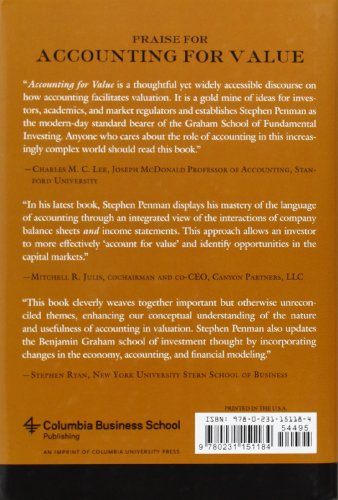Customer Services
Copyright © 2025 Desertcart Holdings Limited
Desert Online General Trading LLC
Dubai, United Arab Emirates




Columbia University Press Accounting for Value
K**S
Excellent!
Excellent!
P**O
A very good book for practitioners
Penman’s book fuses analysis of value and risk using the balance sheet as a starting point. From it, he separates value which can be known with certainty and what is “speculative” value, providing some tools to access how much one should pay for it.Despite starting off slowly with a discussion on what generates value, Penman’s goes on to argue about various interesting points, such as:- Tools for assessing how much one is paying for growth using balance sheet figures as a starting point.- Why DFC models provide a limited understanding of the value generation of a businesses, how accrual accounting provides superior insight and what can be done to address its shortcomings- Limitations of deriving discount rates from CAPM, how to reflect uncertainty and higher risk in the discount rate- Separating value generation from operating sources and leverageMoreover, the book discusses at length about the relationship of more conservative accounting and higher operational risk, linking these with higher returns, which Penman’s argue that may not be entirely due to stronger business franchise, but rather due to accounting policy choices. Finally, the book does a very strong defense of historical cost measurement versus fair value, providing interesting insight on how it grounds analysis and aligns shareholders’ interests. This gives an important understanding of the shortcomings of the increasing adoption of fair value for financial institutions and its impacts on the business cyclicality, risk assessment and even macroeconomic impacts.The minor limitation of the book is that certain topics could use more examples, but that does not reduce its merit of combining fundamental value analysis, accounting and risk in a very elegant and easy-to-read way. I look forward to reading Financial Statements Analysis and Security Valuation to get more insight on these topics.
A**G
Amazing book on security valuation
I have read numerous books on investing by now but felt like all of them fell a bit short when it comes to the valuation of a security. Most valuation methods (like DCF analysis) involve extensive forecasting and speculation about a company's future results. Such forecasting is usually imprecise, especially since it is not unusual that the forecasting horizon spans over 5-10 years.In the book Accounting for Value, Penman presents the idea of separating what we know from what we don't know (speculation), thereby minimizing exposure to risky speculation. Penman argues that growth expectation for a company adds risk since it is not certain that the expecation will be met in the future. Therefore, he proposes to first calculate a no-growth value, i.e., the value of a security excluding any growth prospects. This valuation can be used to challenge the market price for a security (which includes growth expectation) and to assess how much growth the market expects from the company. The calculation of the no-growth valuation is anchored on conservative accounting (what we know), which however can only work if the accounting is done properly. Penman discusses what good accounting is and where current accounting rules like GAAP and IFRS can be improved.Penman presents these ideas in such a methodical and clear way that it's really a pleasure to follow his thoughts throughout the book. The book is probably not suited as a first book on investing, but it offers incredibly valuable insights for advanced investors. It surely is a must-read for any value investor.
A**E
Bravo this is one of the best books I have read
Bravo this is one of the best books I have read.In investing there is three things key. 1) accounting 2) business strategies, which I highly recommend Micheal porters book and his explanation of the 5 competitive forces to help find business with a durable competitive advantage. 3 ) valuation metrics. Most use growth in their intrinsic valuation formula. However, Stephen penman creates a formula without growth because growth is risky I think the approach is genius, because growth is too risky and to hard to predict so it shouldn’t be in the intrinsic value formula. He uses this year estimates next and book value to “ anchor “ a fair valuation. Which I think is way more accurate trying to determine the eps of a stock 10 years from now
G**D
Extremely useful book for advanced investors
This is content rich book suitable only for serious and advanced investors. It is not an easy read. The author is not great writer. I have read his other book also and that falls in same category. One example...He uses different abbreviations than industry. For example ROCE is Return on common equity Not return on capital employed. Penman is advocate of use of regular accounting for valuation. This is marked departure from other value investors who use free cash flow for valuation. But his methods will help you avoid paying too much for stocks and lose money. He asks us to anchor the valuation on what is known (current statements) and very reluctantly and conservatively value (and pay for) future growth.I have been using his residual earnings valuation method for some time with very satisfying results. The key is extreme conservatism and common sense. And willingness to pass many good (in hindsight of course) opportunities. I recommend this book along with his Financial statement analysis and valuation Textbook.
Trustpilot
3 weeks ago
1 month ago